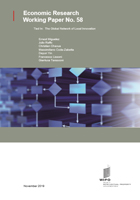Tied In: The Global Network of Local Innovation
Economic Research Working Paper No. 58
Author: Ernest Miguelez
Author: Julio Raffo
Author: Christian Chacua
Author: Massimiliano Coda-Zabetta
Author: Deyun Yin
Author: Francesco Lissoni
Author: Gianluca Tarasconi
Publication year: 2019
DOI: English

In this paper we exploit a unique and rich dataset of patent applications and scientific publications in order to answer several questions concerned with two current phenomena on the way knowledge is produced and shared worldwide: its geographical spread at the international level and its spatial concentration in few worldwide geographical hotspots. We find that the production of patents and scientific publications has spread geographically to several countries, and has not kept within the traditional knowledge producing economies (Western Europe, Japan and the U.S.). We observe that part of this partial geographical spread of knowledge activities is due to the setting up of Global Innovation Networks, first toward more traditional innovative countries, and then towards emerging economies too. Yet, despite the increasing worldwide spread of knowledge production, we do not see the same spreading process within countries, and even we see some increased concentration in some of them. This may have, of course, important distributional consequences within countries. Moreover, these selected areas also concentrate a large and increasing connectivity, within their own country to other hotspots, and across countries through Global Innovation Networks.
